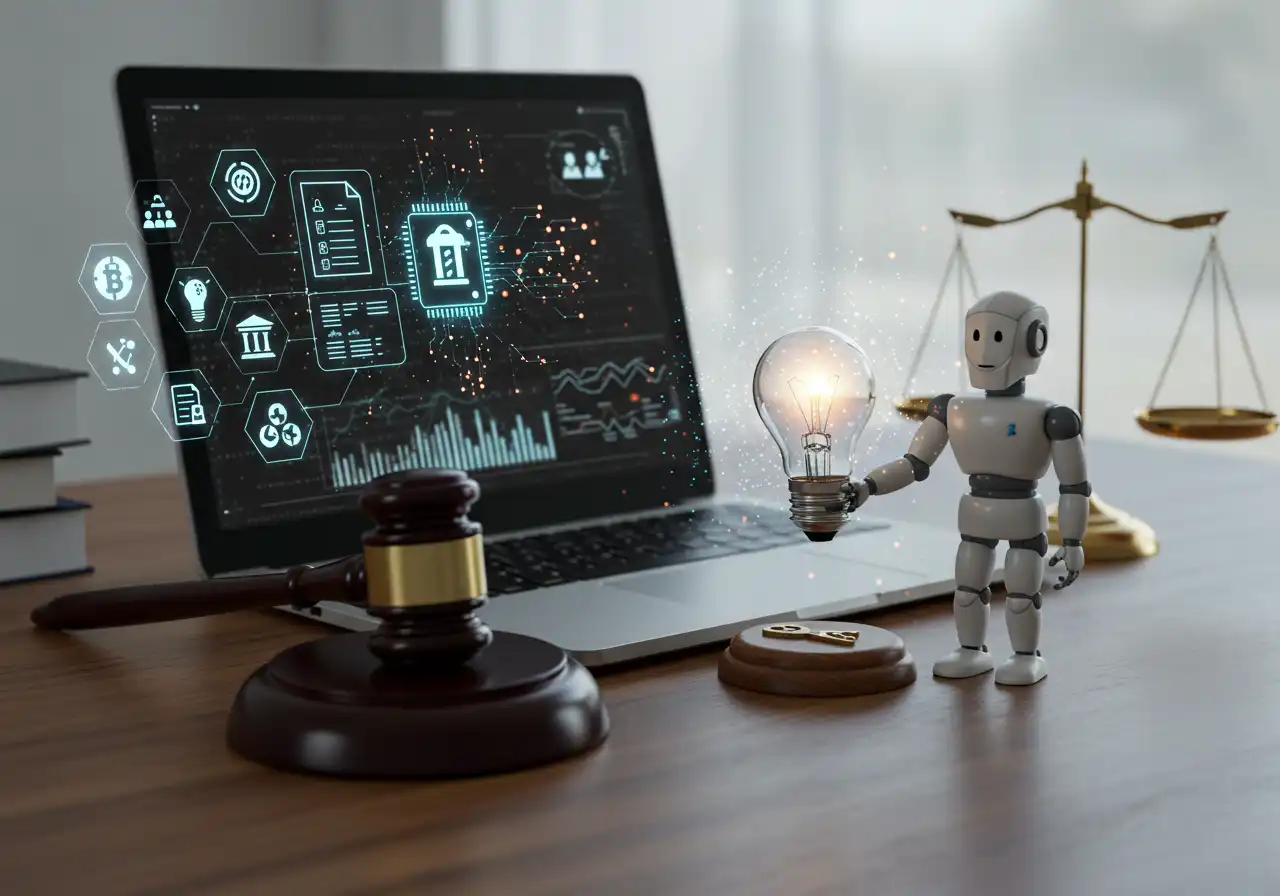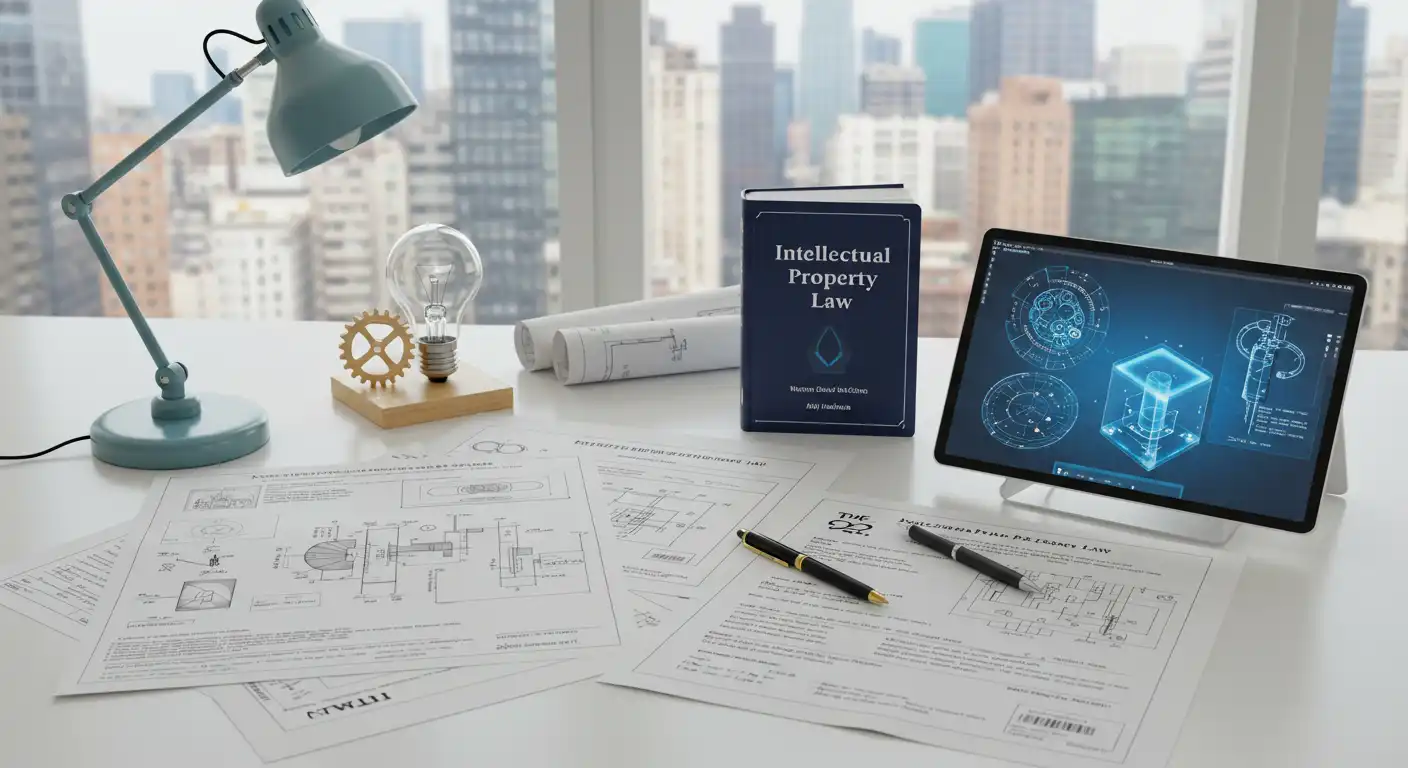The Future of IP Law: Trends Shaping Innovation in 2025 and Beyond
Intellectual Property (IP) law is important for encouraging innovation because it legally protects inventions, designs, and creative works. To understand the future of IP law, we need to know about the trends that will shape innovation in 2025 and beyond.
Changes in technology, the global economy, and society are all affecting IP laws. These changes require flexible legal systems that can handle new problems and possibilities. By keeping up with these trends, everyone involved can make better plans for the future of IP law and protect their innovations.

The Impact of Artificial Intelligence on IP Law
AI-generated inventions present unique challenges in the realm of intellectual property (IP) law, particularly concerning authorship and ownership. Determining whether the creator of an AI system or the AI itself holds rights to an invention raises significant legal questions. This grey area necessitates updates to existing legal frameworks to clearly define ownership and protect the interests of all parties involved.
AI in patent drafting significantly enhances precision and efficiency. Utilizing AI tools for novelty searches and trademark monitoring reduces human error and speeds up the process. These advancements allow for more accurate identification of prior art, ensuring that patents are granted only for truly novel inventions.
Automation of IP management processes through AI and blockchain-powered smart contracts revolutionizes how IP assets are handled. Automated systems streamline tasks such as patent search, filing, rights monitoring, infringement detection, and licensing. Blockchain technology ensures transparency, security, and immutability in these transactions, fostering trust and reliability within the IP ecosystem.
The incorporation of AI into IP law not only addresses current challenges but also opens new avenues for innovation and efficiency in managing intellectual property rights.
Globalization and Harmonization of IP Laws
Globalization has led to significant efforts in harmonizing intellectual property (IP) laws across different countries. The goal of these initiatives is to create a streamlined system for global protection and enforcement, making it easier for innovators to obtain IP rights internationally.
Key International Agreements
Several important international agreements are crucial in this effort to harmonize IP laws:
Patent Cooperation Treaty (PCT): This treaty simplifies the process of obtaining patent protection in multiple countries by allowing applicants to file a single international patent application. It makes the filing process more efficient and cost-effective.
Madrid System: This system enables trademark owners to protect their marks in multiple countries through a single application. It centralizes the management of trademarks across various jurisdictions, providing significant administrative benefits.
Emerging Enforcement Mechanisms
New mechanisms are being developed to handle cross-border IP disputes more effectively:
Unitary Patent: In the European Union, the Unitary Patent provides uniform protection across participating EU member states with one application. It eliminates the need for separate national patents, reducing costs and administrative burdens.
Unified Patent Court (UPC): The UPC is designed to handle patent disputes that arise under the Unitary Patent. It offers a centralized judicial platform for resolving cross-border patent issues, enhancing legal certainty and consistency in rulings.
These efforts towards harmonization reflect a broader trend of integrating global IP systems, fostering innovation by making it easier for inventors to secure and enforce their rights worldwide.

How Blockchain Technology is Changing IP Management
Blockchain IP registration is changing the way intellectual property (IP) management works. It uses a decentralized ledger to provide transparency, security, and immutability for registering and recording IP rights. This means that every transaction or change in ownership is permanently recorded and protected, making it nearly impossible to make unauthorized changes.
The Benefits of Blockchain for IP Management
Here are some key benefits of using blockchain technology for managing intellectual property:
Transparency: Every party involved can see a complete and unchangeable history of IP ownership, licensing, and transfers.
Security: Sensitive information about patents, trademarks, or copyrights is protected from tampering through cryptographic protocols.
Immutability: Once recorded on the blockchain, entries cannot be changed or deleted, providing permanent proof of rights.
How Smart Contracts are Streamlining IP Licensing
Smart contracts for IP licensing are also playing a significant role in improving the efficiency of licensing agreements. These contracts automatically execute license agreements and royalty payments without the need for human involvement. By eliminating the possibility of disputes and reducing administrative costs associated with traditional licensing models, smart contracts offer a more streamlined approach to managing IP rights.
Real-World Applications of Blockchain in IP Law
Here are some core use cases where blockchain technology is being applied in the field of intellectual property law:
Tracking ownership changes for digital art, music, software code, and patents
Managing global licenses with automated compliance checks
Enforcing rights over digital assets (including NFTs) through real-time monitoring
The Future of IP Management with Blockchain
Blockchain technology has the potential to eliminate confusion and human errors from IP processes. As more industries embrace this technology, we can expect to see significant improvements in the efficiency and security of intellectual property portfolio management. This shift will open up new opportunities for creative businesses and innovation-driven sectors.
With its ability to provide transparent records, secure transactions, and automated processes, blockchain is revolutionizing how we manage intellectual property rights. As we move forward into 2025 and beyond, it will be exciting to see how this technology continues to shape the future of IP law.

Sustainability and Green Innovation in IP Law
The growing emphasis on sustainability is driving innovation in eco-friendly technologies, which are increasingly being protected by patents. Green patents are becoming critical assets as companies and inventors strive to develop sustainable technology patents that address environmental challenges.
Role of Governments and International Bodies
Governments and international bodies play a significant role in incentivizing green patent applications. Through policy measures, tax incentives, and grants, these entities encourage the development and protection of technologies aimed at:
Reducing carbon footprints
Conserving resources
Promoting renewable energy sources
Expected Surge in Green Patents
The number of green patents is expected to surge by 2025, reflecting global environmental priorities. This trend underscores how IP law is adapting to support innovations that contribute to a sustainable future.
With environmental concerns taking center stage, the legal framework around intellectual property must evolve to facilitate the growth of green technologies.
Intersection of Data Privacy with Intellectual Property Strategies
Data privacy regulations significantly impact how companies manage intellectual property involving personal data. The General Data Protection Regulation (GDPR) imposes stringent requirements on the collection, storage, and processing of personal data, influencing IP strategies.
Influence of GDPR on IP Management:
Companies must ensure that their IP practices comply with GDPR mandates, particularly when handling digital assets containing personal information.
Non-compliance can lead to hefty fines and legal repercussions, making it crucial for businesses to integrate privacy considerations into their IP management frameworks.
Challenges in Privacy Compliance:
Integrating privacy compliance into digital assets and software-related IP rights poses substantial challenges. Companies need to balance innovation with the need to protect personal data.
Ensuring data protection without compromising the functionality and utility of digital products requires robust privacy measures embedded within the IP strategy.
Key Considerations:
Data Minimization: Implementing principles like data minimization can reduce the risks associated with personal data within IP assets.
Consent Management: Obtaining explicit consent from users for the use of their data is essential under GDPR, affecting how digital innovations are developed and deployed.
Incorporating these considerations into your IP strategy ensures compliance while fostering trust and innovation in a privacy-conscious market.
Digital Transformation in the Practice of IP Law
The adoption of digital tools within intellectual property law has accelerated at an unprecedented pace since the COVID-19 pandemic. Legal professionals and clients now engage through virtual consultations in IP law, eliminating geographical barriers and reducing travel expenses. This shift has transformed the delivery of legal services, making them more agile and responsive to client needs.
Key advancements include:
Electronic Filings: IP offices worldwide have expanded support for electronic submissions of patents, trademarks, and copyrights. This streamlines processes, reduces paperwork, and speeds up response times. Delays from manual processing are minimized, allowing for faster protection of innovations.
Digital Dispute Resolution: Online platforms enable parties to resolve IP disputes efficiently without traditional courtroom proceedings. These systems offer flexibility in scheduling, lower costs, and increased accessibility for individuals or companies unable to attend hearings in person.
Document Management Systems: Cloud-based solutions centralize document storage, improve collaboration between counsel and clients, and provide secure access from anywhere.
Cost-efficiency stands out as a major benefit. Digital transformation means smaller firms can now compete with larger practices by leveraging technology rather than physical infrastructure. As legal teams grow more comfortable with these tools, expect continued innovation in how IP services are delivered—an essential trend within the future of IP law.
Digital transformation creates new expectations for efficiency and transparency, setting the stage for further advances in legislative frameworks and emerging technologies.
Legislative Developments Shaping Future IP Frameworks
Recent legislative activity is redefining the contours of intellectual property law and enforcement across the globe. Several new acts are elevating standards for patent validity and sharpening enforcement against infringement.
New Acts Impacting Intellectual Property Law
PREVAIL Act: Raises the bar for invalidating patents in post-grant proceedings, aiming to provide greater certainty to patent holders. This directly impacts startups and inventors seeking robust protection against challenges from larger competitors.
Patent Eligibility Restoration Act: Clarifies what constitutes patentable subject matter, resolving ambiguity around computer-related inventions and biotechnologies. This provides clearer guidance for innovators in fast-evolving sectors.
Protecting American Intellectual Property Act: Strengthens tools for penalizing foreign entities engaged in trade secret theft or large-scale infringement, signaling a proactive stance on cross-border IP crime.
Legislation Driven by Digital Innovation
Digital innovation is also steering legislation:
National AI Initiative Act: Sets the groundwork for developing national strategies related to artificial intelligence, including how AI-generated works are treated within the IP system. This shapes future policies on ownership and inventorship when AI is involved.
NO FAKES Act: Addresses accountability for digital asset misuse within e-commerce platforms, targeting counterfeit goods and unauthorized digital replicas.
Legislative trends reflect an ongoing shift toward greater clarity, stronger enforcement, and adaptive frameworks tailored to emerging technologies.
Expansion of Virtual Platforms Influencing Patent Landscapes
Virtual reality (VR), augmented reality (AR), and mixed reality (MR) technologies are reshaping what can be patented. As these technologies grow, they are inspiring new inventions in various industries such as entertainment, healthcare, automotive, manufacturing, and remote collaboration.
Companies are competing to secure patents for:
Immersive user interfaces: This includes patents for systems that use gestures, spatial audio, and haptic feedback to create a more realistic experience.
3D modeling and simulation engines: Innovations that allow for the real-time rendering of complex environments are a key area of focus.
Hardware advancements: Patents related to smart glasses, headsets, sensors, and wearable devices that offer improved tracking and comfort features.
Combining virtual and physical spaces presents unique legal challenges. When drafting patent claims for inventions that function in both realms, careful consideration is necessary. For instance:
A patent on an AR navigation system must take into account how real-world data is integrated and the accuracy of the virtual overlay.
Different jurisdictions have varying approaches to software-related inventions that underlie these platforms. Some require proof of a technical effect or inventive step that goes beyond abstract concepts. Patent offices also face difficulties with prior art due to the rapid development and blending of disciplines in this field.
As a result, there is a constantly changing patent landscape where innovators need to stay alert to shifts in examination standards as VR/AR/MR technologies continue to evolve within the intellectual property ecosystem.
Strengthening Intellectual Property Systems in Developing Economies
Developing countries are reshaping the global landscape of innovation through IP reforms. Governments in Africa and Asia are making targeted changes to their national IP laws in order to encourage investment and create thriving innovation ecosystems.
Modernization Initiatives
Countries like Kenya, Nigeria, India, and Vietnam have introduced legal reforms aimed at:
Streamlining patent processing times
Digitizing IP office operations
Clarifying protection for emerging technologies
These actions help reduce bureaucratic obstacles, providing inventors and businesses with faster access to enforceable rights.
Capacity Building
National IP offices are investing in workforce training and implementing modern digital infrastructure. For instance, the African Regional Intellectual Property Organization (ARIPO) offers technical assistance and policy guidance to its member states, while Asian countries utilize programs led by WIPO for examiner training and automation.
International treaty participation marks a significant shift in the future of IP law in 2025 and beyond
Many African and Asian nations have become signatories to treaties such as:
The Patent Cooperation Treaty (PCT)
The Madrid System for trademarks
The Hague System for industrial designs
This enables local innovators to obtain international protection with fewer administrative obstacles.
Investor Confidence
Stronger alignment with global standards boosts foreign direct investment by assuring multinational companies that their intellectual assets will be securely protected.
These initiatives demonstrate a growing understanding that strong intellectual property frameworks are crucial for driving economic growth in developing regions.
Automation Enhancing Efficiency within Legal Departments Handling IP
Legal automation tools are rapidly transforming the way corporate legal departments manage intellectual property portfolios. Routine, labor-intensive tasks such as document review, patent filing, and trademark search processes are now handled by advanced software that streamlines workflows and cuts operational costs.
Patent filing automation
Patent filing automation platforms reduce manual data entry and minimize the risk of human error. These systems generate standardized forms, track deadlines, and facilitate filings across multiple jurisdictions.
Trademark search automation
Trademark search automation tools leverage AI-driven algorithms to scan global databases for potential conflicts, delivering faster and more comprehensive results than traditional methods.
Bulk document review automation
Digital solutions handle bulk document review and flag inconsistencies or incomplete information, supporting legal teams in maintaining accuracy without sacrificing speed.
The impact is evident: legal professionals spend less time on repetitive tasks and allocate more resources toward high-value strategic work such as portfolio management, IP litigation analysis, and innovation strategy development. Companies using these tools report significant improvements in process accuracy and response times for internal stakeholders.
Automation is not just about efficiency; it’s about empowering legal departments to adapt quickly to the fast-paced evolution of IP law. As digitalization continues to advance, expect even more sophisticated solutions tailored for the complexities unique to intellectual property management.
Conclusion
Staying ahead of the future trends of intellectual property law requires constant vigilance and a willingness to adapt. Shifts powered by artificial intelligence, blockchain, data privacy mandates, sustainability goals, and global harmonization all demand that legal professionals, innovators, and business leaders reassess their strategies.
Adaptive legal frameworks are no longer optional—they are the foundation for protecting and leveraging innovation in a hyper-connected world.
To thrive in the future of IP law, you must:
Continuously monitor legislative changes and emerging technologies.
Invest in digital tools that streamline IP management.
Build cross-disciplinary teams capable of navigating complex new realities.
A proactive approach to these changes will empower stakeholders to secure their innovations, minimize risk, and seize opportunities presented by the evolving intellectual property landscape.
